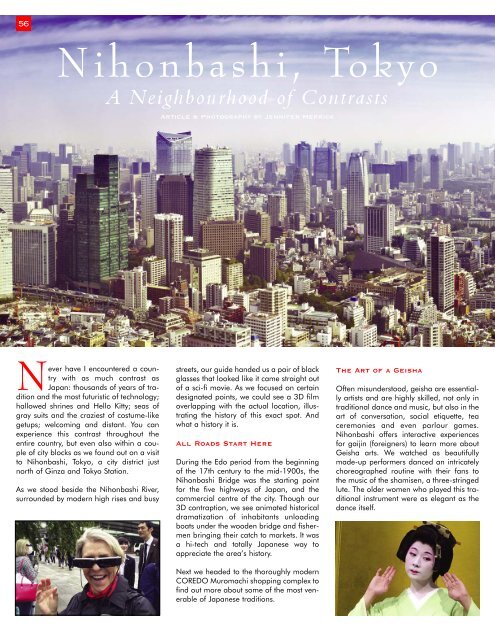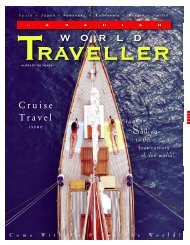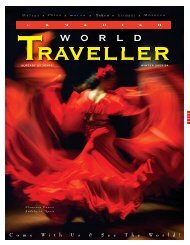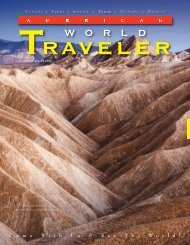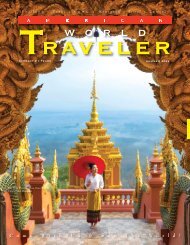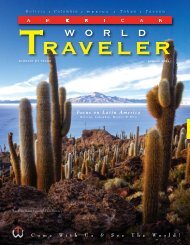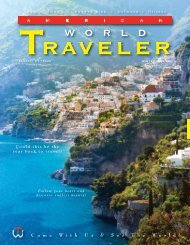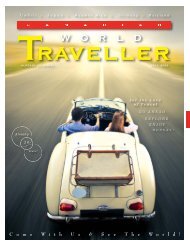American World traveler Spring 2017 Issue
Now in our 15th year of publishing, American World Traveler explores the culture and history of worldwide destinations, sharing the adventure of discovery with our readers and motivating them to make their travel dreams a reality. Published quarterly, AWT helps sophisticated, independent American travelers choose their next destination by offering a lively blend of intelligent, informative articles and tantalizing photographic images from our World’s best destinations, cruises, accommodations and activities to suit every traveler's taste.
Now in our 15th year of publishing, American World Traveler explores the culture and history of worldwide destinations, sharing the adventure of discovery with our readers and motivating them to make their travel dreams a reality. Published quarterly, AWT helps sophisticated, independent American travelers choose their next destination by offering a lively blend of intelligent, informative articles and tantalizing photographic images from our World’s best destinations, cruises, accommodations and activities to suit every traveler's taste.
Create successful ePaper yourself
Turn your PDF publications into a flip-book with our unique Google optimized e-Paper software.
56<br />
Nihonbashi, Tokyo<br />
Never have I encountered a country<br />
with as much contrast as<br />
Japan: thousands of years of tradition<br />
and the most futuristic of technology;<br />
hallowed shrines and Hello Kitty; seas of<br />
gray suits and the craziest of costume-like<br />
getups; welcoming and distant. You can<br />
experience this contrast throughout the<br />
entire country, but even also within a couple<br />
of city blocks as we found out on a visit<br />
to Nihonbashi, Tokyo, a city district just<br />
north of Ginza and Tokyo Station.<br />
As we stood beside the Nihonbashi River,<br />
surrounded by modern high rises and busy<br />
streets, our guide handed us a pair of black<br />
glasses that looked like it came straight out<br />
of a sci-fi movie. As we focused on certain<br />
designated points, we could see a 3D film<br />
overlapping with the actual location, illustrating<br />
the history of this exact spot. And<br />
what a history it is.<br />
All Roads Start Here<br />
During the Edo period from the beginning<br />
of the 17th century to the mid-1900s, the<br />
Nihonbashi Bridge was the starting point<br />
for the five highways of Japan, and the<br />
commercial centre of the city. Though our<br />
3D contraption, we see animated historical<br />
dramatization of inhabitants unloading<br />
boats under the wooden bridge and fishermen<br />
bringing their catch to markets. It was<br />
a hi-tech and totally Japanese way to<br />
appreciate the area’s history.<br />
Next we headed to the thoroughly modern<br />
COREDO Muromachi shopping complex to<br />
find out more about some of the most venerable<br />
of Japanese traditions.<br />
The Art of a Geisha<br />
Often misunderstood, geisha are essentially<br />
artists and are highly skilled, not only in<br />
traditional dance and music, but also in the<br />
art of conversation, social etiquette, tea<br />
ceremonies and even parlour games.<br />
Nihonbashi offers interactive experiences<br />
for gaijin (foreigners) to learn more about<br />
Geisha arts. We watched as beautifully<br />
made-up performers danced an intricately<br />
choreographed routine with their fans to<br />
the music of the shamisen, a three-stringed<br />
lute. The older women who played this traditional<br />
instrument were as elegant as the<br />
dance itself.


